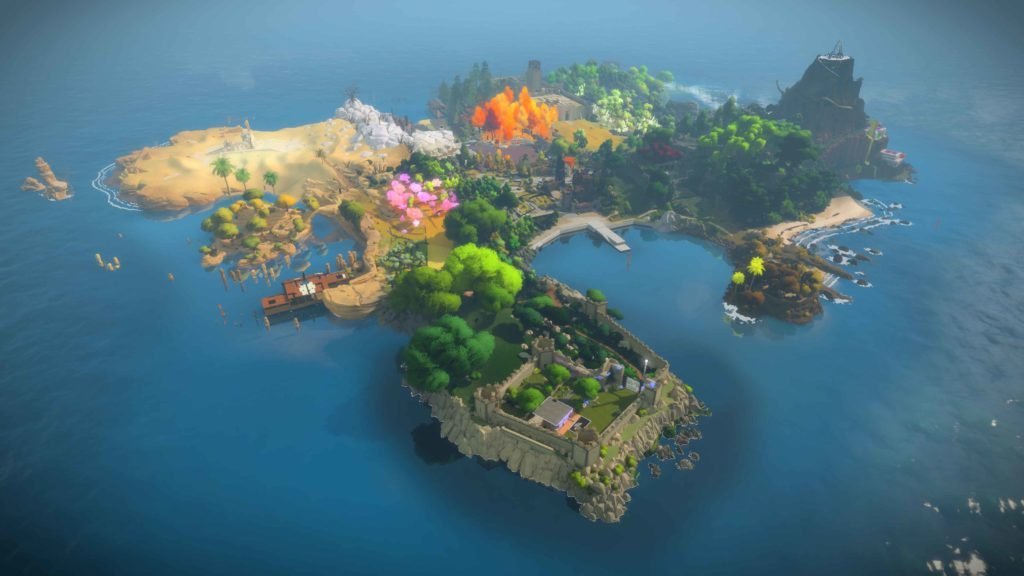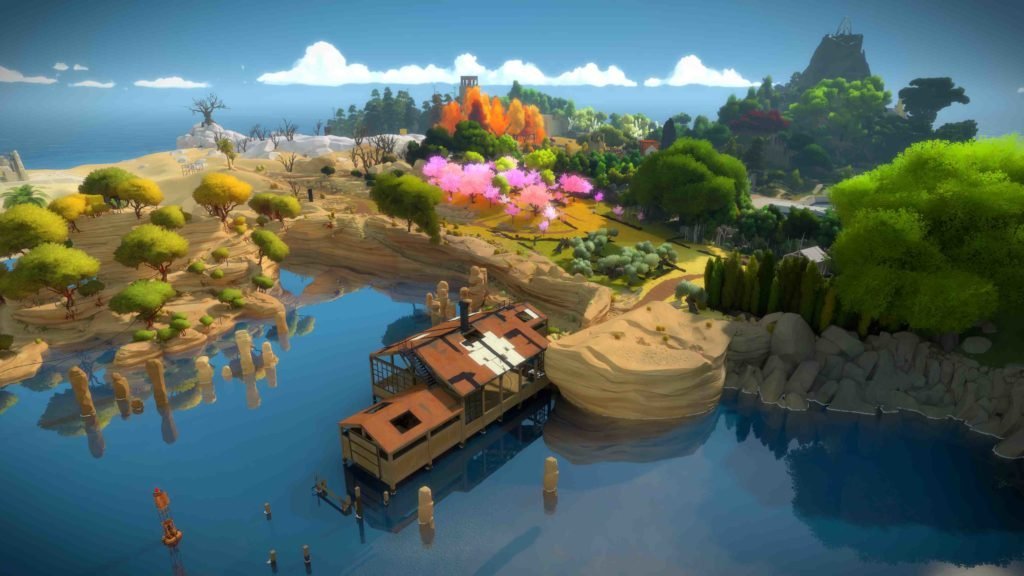The Witness Review
Modern gaming has changed a lot since the days of Myst and Riven. While at the time the point and click, single-screen slideshow-esque set up was considered an immersive open world, games have now progressed to fully realized 3D spaces. Simultaneously, the majority of puzzle games have transitioned either into indie adventure titles or mobile games. It’s in the midst of all of these differences and conflicting ideas that The Witness emerges with the simple genius to combine all of it together.Even as it gives you a colorful, mysterious island to explore, The Witness is first and foremost a brutally hard puzzle game. Very quickly, it makes clear it’s not just a good idea to take notes, it’s an absolute necessity. Emerging on the other side of my thirty-two hours with The Witness, my phone full of dozens of pictures, and an entire page of scribbled notes in hand, I can say no game has ever pushed me the way The Witness did. And few games have ever felt quite as satisfying.

Modern gaming has changed a lot since the days of Myst and Riven. While at the time the point and click, single-screen slideshow-esque set up was considered an immersive open world, games have now progressed to fully realized 3D spaces. Simultaneously, the majority of puzzle games have transitioned either into indie adventure titles or mobile games. It’s in the midst of all of these differences and conflicting ideas that The Witness emerges with the simple genius to combine all of it together.
Even as it gives you a colorful, mysterious island to explore, The Witness is first and foremost a brutally hard puzzle game. Very quickly, it makes clear it’s not just a good idea to take notes, it’s an absolute necessity. Emerging on the other side of my thirty-two hours with The Witness, my phone full of dozens of pictures, and an entire page of scribbled notes in hand, I can say no game has ever pushed me the way The Witness did. And few games have ever felt quite as satisfying.
The entire thing is built on the simplest of mechanics: drawing a line. Every puzzle stems from drawing a single, unbroken line from point A to point B, and that’s it. What’s remarkable however, is how The Witness takes such a simple mechanic and turns it into one of the most engrossing puzzle systems imaginable.

Throughout the island, you’ll find panels, sometimes hidden, sometimes right out in the open. On each panel, regardless of the design, there is a starting point and an end point, and it’s your job to connect them. Where the line should go in between, what path it takes, what design you have to complete is all based on what you can see.
Many of the puzzles have shapes on them, each alluding to different requirements. A hexagon in one of the lanes means you have to draw the line to cover it. A set of different colored squares means you have to draw the line to separate them from each other. The Witness quickly ramps up the complexity with more and more interesting rules, but figuring out those rules for yourself is most of the fun.
In many ways, its reminiscent of the levels you’d find in a mobile game, The Witness’s 600+ puzzles the stages you’d scroll through with a tap of your fingers.
And possibly that’s why the puzzles feel so natural. Even set in a gorgeous, detailed island dripping with homage to Myst and other puzzlers that have come before, The Witness feels completely contemporary and at home in modern gaming.
Jonathan Blow, the game’s creator, and the rest of the development team at Thekla Inc. didn’t stop there however. Some puzzles don’t have symbols on the panel telling you how to solve them. In those cases you are left to find the solution in the environment itself. Everything from shadows to the branches of trees, and even the very perspective you look at the puzzle from, can give you the clues you need to solve it. And, even more than figuring out the solutions to the complex but straight forward puzzles, wrapping your head around one of the devilishly clever environmental ones is incredibly rewarding.
In this way, among others, the entirety of the island becomes a puzzle in itself to solve, the ideas of color, perspective, light, and shadow all coalescing into an interconnected web across the island. Every puzzle leading to the next, the way in which everything is related is a mind-warping joy to discover.
And more than anything, that’s the driving force behind The Witness, that sense of discovery and the elation that comes from knowing you understand more now than you did before. Other than the basic controls of the game, The Witness doesn’t tell you anything. It doesn’t tell you the end goal, doesn’t tell you how to get there, and certainly doesn’t tell you to how to solve any of its puzzles.
While there is an end goal, a specific way to get there, and specific ways to solve every puzzle, it’s left to you as the player to find it all on your own. As you explore and learn more about how the game works, The Witness gives you all the tools you need, but does it in such a way that allows (forces) you to figure it out yourself, no handholding in sight.
The open world of the island meant I found some puzzles long before I was ready to do them. After struggling and finally giving up however, there was always a different puzzle to go do. That’s part of why The Witness’s incredible difficulty is palatable. You don’t have to do everything. If you can’t solve one puzzle, it only impedes your progress in a specific area, with the other areas of the island ready to be explored and solved in the meantime. Having learned more, discovered more about a specific rule set or figured out another ingenious way to look at the environment, then coming back to those previously impossible puzzles and knocking them out in a single triumphant go was thrilling.
When I said before that The Witness was brutal, I meant it. There’s no hint system or get-out-of-jail free card, and there’s more puzzles than I will likely ever solve. Even completing every major set of puzzles I could find, more than are even necessary to complete the game, I know for a fact I still only scratched the surface of the island and its mysteries. As I prepared to end the game, I was still finding new things that changed how I looked at the world and opened my eyes to the connections that had been there the whole time, but I had simply never seen.
There were many moments I just had to set down the controller, having agonized over a given puzzle for longer than I would care to admit, cursing the lack of a hint system. But every time, coming back, there’s the assurance the answer, no mater what, was no more than a line. And inevitably, I found the solution, each time thankful there hadn’t been an easy way out.
As a game, The Witness knows what it is and exactly what it means to do. Thekla Inc. doesn’t flinch from this singular commitment for a moment, and the entire experience is better for it. From start to finish, the game works as a masterful, cohesive whole. With a nonexistent musical soundtrack, the only sounds you hear are the natural noises of the world itself, the crunch of your feet on the leaves, and the gentle electronic hum of each panel as you work on it. There’s a narrative in the game, but nothing like what you’d expect. No characters or plot, but a narrative all the same.
More than just that however, The Witness manages to take all of these aspects and present something rarely attempted by games, a philosophy. Through the unique audio files hidden away across the island, and in more ways I’m hesitant to spoil, The Witness is a game actually about the importance of knowledge, what it means to ‘understand,’ and the role of science and investigation in our lives. Why do we push forward and solve the next puzzle? Because we can, because it will help us solve the the one after that. Overall, it leads to confidently designed game that’s not afraid to ask everything of the player.
If there’s anything I’m left not feeling as comfortable with, it’s the fact the game seems to reset when you finish. While I won’t say anything in regards to the exact details, the end itself keeping true to the same core philosophy as the rest, the final result is the appearent erasure of any progress. This includes the major puzzle lines I had finished, but also the extras I had not. As it turns out, this is not the case. Going back through the game menus once you start a new game still enables you to start up your old game from right before the ending. The confusion alone however was still enough to leave a slightly bitter taste as the game came to an close.
Regardless, there’s no doubt that The Witness is an outstanding game, unparalleled in today’s industry. The difficulty is punishing. But overcoming it is satisfying and well worth the patience and head scratching it takes to get through. Both clever and beautiful, the world is interesting to explore and the mysteries more than enticing enough to sink yourself into. Thekla Inc. blends modern gaming with the best of puzzle-gaming’s legacy.
